Viewing: Class Updates
June 20, 2017
Congratulations FIFTH GRADERS!
The last day of school is always bittersweet for me. I’ve fortunate to be able to say that I’ve always LOVED my classes, and this year’s class was no different. You have some AMAZING children, and I want you all to know how much I’ve enjoyed being your child’s teacher this year. Terrific students make my job easy! Have a wonderful summer!
Mrs. Rafferty, Miss O, and I also wanted to thank you all for the kind and generous gifts that you shared with us at the end of the year. You’ve been so thoughtful to us this year, and we’ve appreciated it each and every day!
We took these photos during our graduation celebration today. Enjoy! To save a photo, right click on it when it appears during the slideshow!
Posted in Class Updates|By Jon Moss
June 15, 2017
Before you speak…
Hello, families! We are in our home stretch with only 2.5 days left. Today, we enjoyed a wonderful town meeting in which the fourth graders performed their song 50 Nifty United States, and a terrific pizza party and summer birthday celebration. We ended the day with a series of water balloon games. All in all, it was a terrific day!
Yesterday, we had a small issue of gossiping in our class. Students felt that other classmates were talking about who they supposedly “liked” (yes, that kind of “liked”) and were embarrassed. We had a great conversation about stopping to think before sharing information (whether it’s real or not) about another person. I wanted to take a moment and share with you one resource you can use:
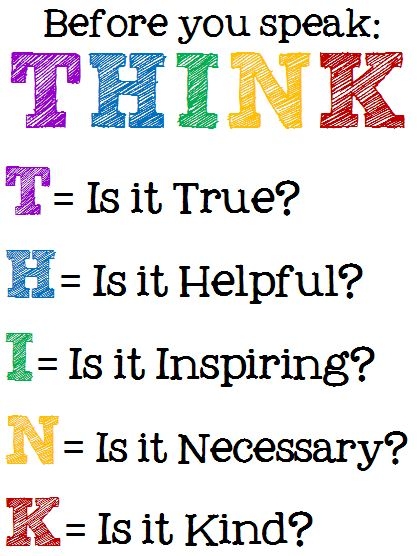 What I like about this graphic is that it outlines specific questions kids can ask themselves before starting to talk about their classmates. As your students get older and older, this will end up being a bigger and bigger issue they face, so I wanted to start the conversation now. We discussed how gossip about others is particularly hard to control, because it can feel fun. It’s fun to share “news” with others, and people love hearing the scoop on others they know. There are plenty of reinforcements to perpetuate gossip among kids: people like talking with you, people laugh or get excited by your “news”, etc. So our conversation focused more on identifying those obvious positives to gossiping, and especially on finding the often unseen negatives (it’s hurtful to others, it’s not your business, and it’s often untrue.) We all agreed that the negatives outweigh the positives. Feel free to refer to this THINK tool when speaking with your kids. It’s particularly good for discussing what should be written online.
What I like about this graphic is that it outlines specific questions kids can ask themselves before starting to talk about their classmates. As your students get older and older, this will end up being a bigger and bigger issue they face, so I wanted to start the conversation now. We discussed how gossip about others is particularly hard to control, because it can feel fun. It’s fun to share “news” with others, and people love hearing the scoop on others they know. There are plenty of reinforcements to perpetuate gossip among kids: people like talking with you, people laugh or get excited by your “news”, etc. So our conversation focused more on identifying those obvious positives to gossiping, and especially on finding the often unseen negatives (it’s hurtful to others, it’s not your business, and it’s often untrue.) We all agreed that the negatives outweigh the positives. Feel free to refer to this THINK tool when speaking with your kids. It’s particularly good for discussing what should be written online.
Posted in Class Updates|By Jon Moss
May 1, 2017
All about SBAC!
 Tomorrow is our first day of SBAC testing! Tomorrow morning we will have our first ELA (English/Language Arts) test. After the practice we’ve done, I’m confident that the kids are ready for their third year of computer-based testing. Here are a few things that I’ve highlighted for kids (whether in whole-class discussions or private conversations), which you might also want to remind them:
Tomorrow is our first day of SBAC testing! Tomorrow morning we will have our first ELA (English/Language Arts) test. After the practice we’ve done, I’m confident that the kids are ready for their third year of computer-based testing. Here are a few things that I’ve highlighted for kids (whether in whole-class discussions or private conversations), which you might also want to remind them:
- You’re prepared! I can easily remember the days of the Connecticut Mastery Tests, which were the state tests students took prior to SBAC. We did weeks and weeks of preparation. Review packets, strategy groups, special homework assignments, and other SPECIAL activities helped to prepare students, but they also accomplished two undesirable outcomes: (1) By seeing so many activities designed to help PREPARE them, students may have formed the impression that they were not otherwise prepared for the test. What a terrible feeling! (2) By seeing so many activities put into place just for the CMTs, students developed a deep understanding that the CMTs were a “big deal.” This did nothing to help students relax. I’m happy to report that our approach has shifted. The SBAC is aligned to the Common Core, as are our curricula. So as long as I’m confident that I’m teaching our curricula well (I think so!), your students should be prepared for SBAC. The fourth grade teachers have led some practice sessions to focus on the actual process of how to complete the test. But as for skill review, we’ve opted for business as usual. This helps me to convince students of what I truly believe to be true: They’re ready!
- “The SBACs will ___ and will not ____.” You might be surprised what misconceptions kids have about the SBACs. Recently, I was asked if poor performance on these tests will prevent kids from going to fifth grade (no) or if it will keep kids from getting into college (double no). I try to be absolutely direct when telling what effect the SBACs will and will not have. (If you have a question about this, please ask me.)
- “It’s ok to be worried!” I think we have a tendency to try to remove kids fears by saying “Oh, don’t worry!” or “There’s no reason to be nervous!” The truth is, if a child is worried about the test, then clearly they feel that they have a reason to worry. I try to validate their feelings, and I instead focus on helping them to stop feeling worried, not on telling them to stop worrying. It’s absolutely normal for students to feel some anxiety about testing. As much as we try to reassure the kids, they understandably pick up on the importance of the tests, and they sometimes feel pressure, despite our best efforts to the contrary. I encourage you to remind your fourth grader that we ask only that they try their very best as they take the tests and that they think about and use all the strategies they’ve learned in school.
- “Just try your best.” I have been very direct with kids – I ask them just to try their very hardest. If they can honestly tell me that they did, then I’m proud of them. But part of trying your best means taking time to remember the things you have been taught and making yourself think carefully about your choices during an assessment, not just picking the first answer that looks decent so that you can move on to the next item. It also means CHECKING OVER your work. When you give encouragement for your kids, focus on effort (“Try your hardest!”) rather than on outcome (“Get a great score!”) in order to minimize pressure.
- “Sleep.” A sleepy student is predisposed to performing poorly on the SBACs. Please make sure that your child gets PLENTY of sleep the night before a test. (Consider enforcing earlier bedtimes, if you deem it appropriate.)
- “Have a calm morning.” By the same token, please try to minimize morning stress. Coming to school late and/or coming after a chaotic morning will put your child in a bad mind-set for testing.
- “Dress comfortably.” Nobody is worried about fashion during this week of testing. Kids should dress in a comfortable outfit that doesn’t distract them as they work. (Haven’t we all been bothered by an itchy label or a pair of shoes that doesn’t fit quite right?)
- “Eat breakfast.” A filling, nutritious breakfast is also essential to good test performance. (Growling stomachs will distract your child, and, frankly, other students too.) Please try to make sure your child has breakfast at home. Healthy snacks will be provided for students before testing, but there is no substitute for a good breakfast.
Feel free to reach out to me if you have any questions!
Posted in Class Updates|By Jon Moss
March 31, 2017
Introducing: Teach Us Something, Somehow

Jon speaking at the 2015 CECA/CASL conference about Teach Us Something, Somehow.
Today, we launched our spring research project, Teach Us Something, Somehow. I developed this project in 2011 as a way of helping students to focus on the process of research and project management, rather than on a specific product. This project aims to help students to develop problem solving skills, time management abilities, and much more. This afternoon, students will be bringing home an assignment packet that explains the project, steps involved, and deadlines. Next week, we will have two family information sessions where you can come, learn more about the project, see sample projects, and ask questions. We are happy to meet with you Tuesday between 3:45-4:30 and Wednesday between 7:45-8:30. Both sessions will be in the library. You can also visit the Teach Us Something, Somehow (TUSS) website at www.mossteaches.us/tuss, where you can download paperwork and read through frequently asked questions (FAQs).
Posted in Class Updates|By Jon Moss
February 28, 2017
We are authors!
I tell students that they’re authors the moment they first put pencil to paper, whether in preschool, kindergarten, or beyond. But recently, we’ve been fine-tuning their skills, to say the least! Over the past few weeks, students in Room 209 have been working to develop their narrative writing (story writing) skills. This is a skill they’ve worked on repeatedly over the years, and in fourth grade, we focus on how to plan your story before writing in order to develop a well-crafted narrative. To that end, we spent the first few weeks of the unit (in fact, the majority of the unit) working on planning a story. Students developed a plot that included a problem that they were able to resolve, a solution that was connected to the events leading up to it (as opposed to being a coincidental resolution of the story line that “just suddenly happened”), characters that have distinct traits and characteristics, etc. After conferencing with Miss O, Miss Stevens (our new Avon High School intern), or me, students began drafting their stories. This week, we’re focusing on crafting an effective beginning for the story that hooks the reader. Our upcoming focuses will be on endings, developing key moments, and the often overlooked process of revising and editing writing.
I encourage you to visit your child’s Google Classroom page with him/her to learn more about the work we’ve been doing. As always, I ask you to remember that your fourth grader’s work is truly “work in progress” and that you can best support him or her by asking good questions and allowing him or her to share, not by making corrections or improvements to the work itself. Please allow us to do this in class, instead.
Posted in Class Updates|By Jon Moss
February 9, 2017
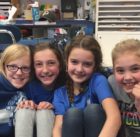
Superbowl Reading Challenge
We had a great time at our Superbowl tailgate party last Friday! Congratulations to all the students who read so much during the past two weeks!
Posted in Class Updates|By Jon Moss
January 26, 2017
Update on Number the Stars (Day 4 of 5)
Last Friday’s lesson focused primarily on dramatic terms and activities to help the kids to get prepared for the rest of the week. On Monday, students learned more about the character of Ellen Rosen, a young Jewish girl living in Copenhagen, whose life has changed because of the Nazi presence. The kids learned a bit about what was happening during the Holocaust, and particularly how it affected Ellen’s relationship with her non-Jewish friend, Annemarie. These programs tend to progress through key parts of the book, so Wednesday’s activity focused on a section that took place later on in the novel, where Ellen’s family learned that they must leave in order to avoid being captured by the Nazi soldiers. The kids learned that Annemarie’s family willingly accepted Ellen to stay with them, in hopes of protecting her, while Ellen’s parents sought protection in some other way (that we don’t yet know about). As they had in previous days, the kids participated in some dramatic activities to act out some of the conversations and situations that the young girls found themselves in.
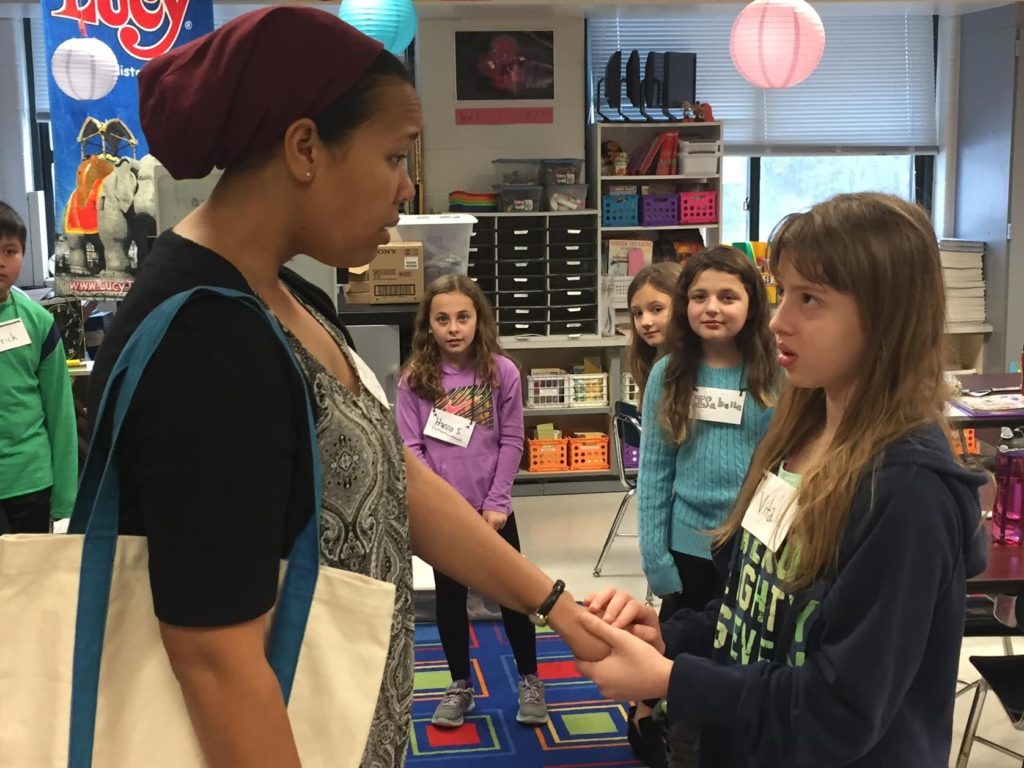 Today’s activities were the most dramatic and revealing. This morning, the kids were invited to role-play what it would be like for them, playing the role of Ellen’s parents, to say goodbye to their daughter who was staying with another family for her own protection. This was a very dramatic activity for the kids, as they had to explain to Aurelia, who was playing the role of Ellen, their daughter, why they could not stay with her, and why it was not safe for her to come with them. They did a wonderful job thinking about what the parents would actually say to their daughter in that situation, and they showed their understanding of what they had been taught on previous days.
Today’s activities were the most dramatic and revealing. This morning, the kids were invited to role-play what it would be like for them, playing the role of Ellen’s parents, to say goodbye to their daughter who was staying with another family for her own protection. This was a very dramatic activity for the kids, as they had to explain to Aurelia, who was playing the role of Ellen, their daughter, why they could not stay with her, and why it was not safe for her to come with them. They did a wonderful job thinking about what the parents would actually say to their daughter in that situation, and they showed their understanding of what they had been taught on previous days.
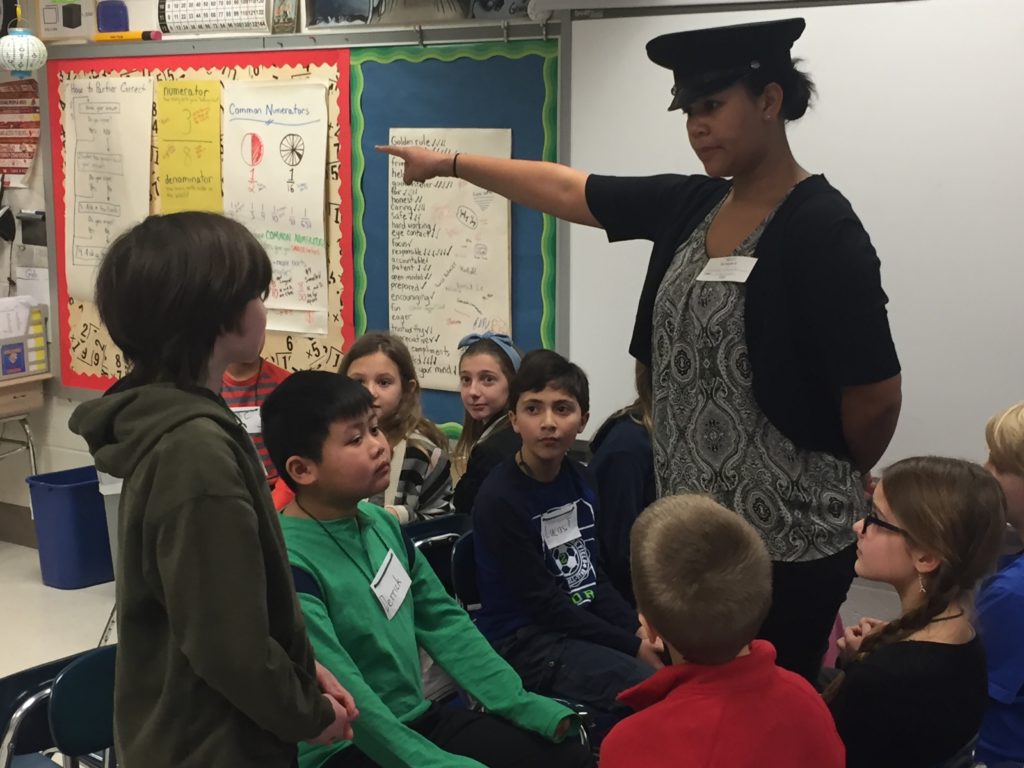 The final activity from today, however, was the most emotional, and, I think, eye-opening for the kids. By moving desks and chairs, our class was transformed into a train traveling out of Denmark. A Nazi soldier, again played by Aurelia (the theater educator), boarded the train and began to interview the passengers (the kids in our class). The kids were all assigned different roles, such as being a member of a Jewish family, being a member of a group of non-Jewish colleagues who were traveling for business, and other various roles. As they were questioned by the Nazi soldier, the kids did a very impressive job sticking to their characters as they tried to prove that they should not be targets of the soldier’s investigations. As really happened in history, the soldier identified many people, Jews and non-Jews, that she thought needed to be taken off the train. Passengers (the kids) were forced to quickly think on their feet and to come up with explanations to try and save themselves and their companions. This sparked a rich discussion later on as we discussed what the kids were thinking about during the activity.
The final activity from today, however, was the most emotional, and, I think, eye-opening for the kids. By moving desks and chairs, our class was transformed into a train traveling out of Denmark. A Nazi soldier, again played by Aurelia (the theater educator), boarded the train and began to interview the passengers (the kids in our class). The kids were all assigned different roles, such as being a member of a Jewish family, being a member of a group of non-Jewish colleagues who were traveling for business, and other various roles. As they were questioned by the Nazi soldier, the kids did a very impressive job sticking to their characters as they tried to prove that they should not be targets of the soldier’s investigations. As really happened in history, the soldier identified many people, Jews and non-Jews, that she thought needed to be taken off the train. Passengers (the kids) were forced to quickly think on their feet and to come up with explanations to try and save themselves and their companions. This sparked a rich discussion later on as we discussed what the kids were thinking about during the activity.
There is no doubting that this is a very realistic activity. One of the challenges in teaching kids about the Holocaust is helping kids to develop a frame of reference. Here, fortunately, the kids in our class do not generally have any basis for understanding the concepts of genocide, hatred, and Anti-Semitism. We work very hard to give the kids an understanding of what happened, and an ability to relate to the experiences of people who lived during that time, while not putting the kids under undue stress.
Following these activities, the kids and I always have follow-up conversations, and I encourage kids to share their feelings and their concerns. I always reassure the students that these are events that happened long ago, and that they are safe here in their homes, in Connecticut. When the kids share how sad it is to learn about this, I remind them about the importance of learning about these historical events, among other reasons, so that we can make absolutely sure that nothing like this ever happens again. We had a wonderful conversation about the challenges that people in Europe (Jews and non-Jews) faced in the 1930’s and 1940’s, and I was really impressed by the kids’ mature contributions to the discussion.
Some of the kids may come home and start discussions about these activities. I encourage you to continue to have these discussions with your children, as I try to avoid going into some of the more graphic details with kids. Students are explicitly asked to avoid discussing these topics during lunch and recess so that they can benefit from having an adult to facilitate the conversations.
If your son and daughter seems concerned or stressed by what they’ve learned, I encourage you to remind them, first and foremost, that their feelings are understandable and valid! I never tell kids “not to be upset” because the material we are learning about is, in fact, upsetting. It’s understandable for kids to feel upset and saddened by the events, but if they are afraid, I remind them that these are events from long ago, and that they are safe in their own communities. I also remind them that the police in their community are very different from the Nazi soldiers who patrolled the streets in Copenhagen, and that the police officers in their town are trustworthy, safe people who really are there to help and protect them.
Tomorrow will be the last day of the role playing activities. They will learn about some of the later events in the text, and at the end, the students will receive copies of the novel, which we will read in school together. This week’s activities will serve as a framework for when we read the novel together. I ask that you continue to discourage your kids from reading or learning about the book until we read it in class together.
Please continue to be in touch with me if you have any questions as we continue this important unit.
Posted in Class Updates, Student News|By Jon Moss
January 23, 2017
Update on Number the Stars (Day 2 of 5)
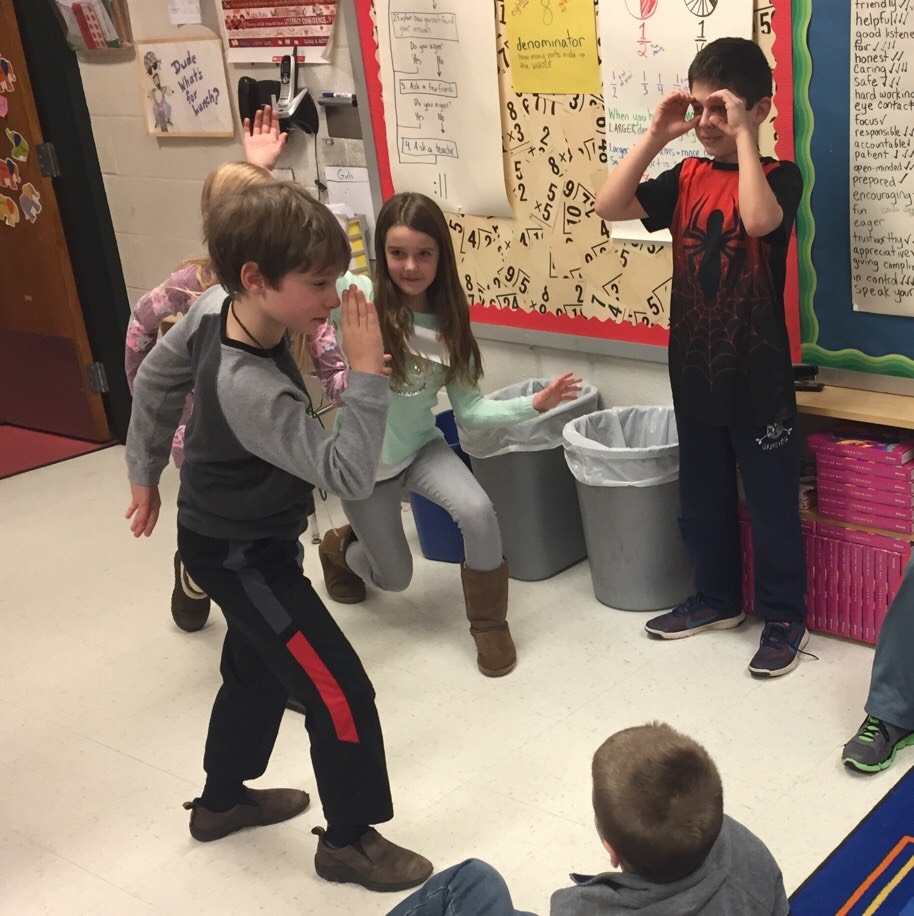 Today, Aurelia from The Hartford Stage came for our second day of learning about Number the Stars. The kids began by pantomiming several scenes, such as acting in a school play, blowing out the candles on a birthday cake, etc. The kids really enjoyed figuring out how to act out those scenes, especially since these moments were so familiar to them. Following these tableaux, Aurelia led the students in a safe discussion about what was happening in and around Copenhagen (the setting of the story) in the 1930s. She introduced the concept of the Holocaust, and I was surprised by how much many students already knew. She explained that Hilter looked for someone to blame for the problems happening in Germany and that the Jews were made into scapegoats. She shared that, eventually, many of the Jews were rounded up and sent to concentration camps where many worked and many perished. The kids took this topic seriously, and I admire their maturity during the discussion. I should say that there are times when students have additional prior knowledge and may start to share more sensitive information than what we’d normally choose to include. Aurelia and I both redirect the conversations when this happens, and we remind kids that some things are best discussed with families at home. There were a few instances of this today, and we were able to shift the focus back to what we were trying to address. In the event that something particularly sensitive is shared by a student in front of the whole class, I’ll, of course, give you a heads-up so you can be prepared for questions at home. On that note, today, a student brought up the idea of gas chambers. I tried to quickly move past this comment, as it’s not something that needs to be a focus in our unit.
Today, Aurelia from The Hartford Stage came for our second day of learning about Number the Stars. The kids began by pantomiming several scenes, such as acting in a school play, blowing out the candles on a birthday cake, etc. The kids really enjoyed figuring out how to act out those scenes, especially since these moments were so familiar to them. Following these tableaux, Aurelia led the students in a safe discussion about what was happening in and around Copenhagen (the setting of the story) in the 1930s. She introduced the concept of the Holocaust, and I was surprised by how much many students already knew. She explained that Hilter looked for someone to blame for the problems happening in Germany and that the Jews were made into scapegoats. She shared that, eventually, many of the Jews were rounded up and sent to concentration camps where many worked and many perished. The kids took this topic seriously, and I admire their maturity during the discussion. I should say that there are times when students have additional prior knowledge and may start to share more sensitive information than what we’d normally choose to include. Aurelia and I both redirect the conversations when this happens, and we remind kids that some things are best discussed with families at home. There were a few instances of this today, and we were able to shift the focus back to what we were trying to address. In the event that something particularly sensitive is shared by a student in front of the whole class, I’ll, of course, give you a heads-up so you can be prepared for questions at home. On that note, today, a student brought up the idea of gas chambers. I tried to quickly move past this comment, as it’s not something that needs to be a focus in our unit.
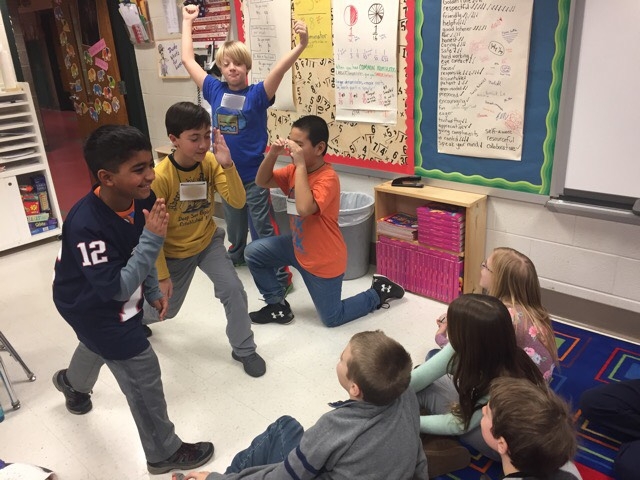 Toward the end of the activity, students thought about what sounds they’d hear in a war zone. Ideas included explosions, gun shots, car engines roaring, people shouting, etc. Students made a “sound circle” where they created a cacophony of the sounds they’d expect to hear during a time of war. Finally, one group of four students recreated the previous tableaux of those familiar moments, but this time, with the “soundtrack” of the sound circle. This helped the kids to imagine how so many of these familiar moments would be different during wartime. Kids shared how they’d feel if they had to live during these situations, and their comments were deep. As I said in a previous message, these students don’t have much understanding of ideas like war, persecution, or hatred, and activities like these help them to understand these concepts a bit better.
Toward the end of the activity, students thought about what sounds they’d hear in a war zone. Ideas included explosions, gun shots, car engines roaring, people shouting, etc. Students made a “sound circle” where they created a cacophony of the sounds they’d expect to hear during a time of war. Finally, one group of four students recreated the previous tableaux of those familiar moments, but this time, with the “soundtrack” of the sound circle. This helped the kids to imagine how so many of these familiar moments would be different during wartime. Kids shared how they’d feel if they had to live during these situations, and their comments were deep. As I said in a previous message, these students don’t have much understanding of ideas like war, persecution, or hatred, and activities like these help them to understand these concepts a bit better.
Following these activities, I always remind students of a few things: (1) They are completely safe. We’re studying events from our world’s history, and by learning about them, we can work to ensure that they never happen again. But they are absolutely safe in their homes, school, and community. (2) These topics should be discussed when there’s an adult there to facilitate the conversation. So this isn’t appropriate conversation for the lunchroom, playground, bus, etc. (3) There are some things that might be upsetting or alarming. Kids can always come to me if they’re feeling worried or anxious, and they can talk to their grownups at home as well.
Posted in Class Updates|By Jon Moss
January 19, 2017
Multicultural Day Tomorrow!
Note: Today, we launched a new class job: Cub Reporter. The Cub Reporter will be responsible for writing a bit about class activities for our class website. As always, student privacy is critically important online, so I credit students by their class number, not by name or initials.
By #12
Tomorrow, our class will be participating in a program called Multicultural Day. That is when we will head to the gym and do many different activities that other cultures do. If you have any clothes that represent your country, you can wear it tomorrow to the Multicultural Fair if you like. We will also do a project where we make a paper suitcase at home and color and print out clipart or a photo of what you own inside of your suitcase. The picture will have to represent the place where you or your ancestors came from. You can put in such as a type of clothing, toys, pictures, food, etc. Your parents will help you with researching your ancestors or learning some new things about yourself. They can also help you print and “pack” your things into the suitcase. Our “suitcases” will be displayed open and showing the objects that you put inside. Everyone will have to put a passport or tag with their name on the handle of the suitcase. I hope that we all have fun making the project and at the Multicultural Fair!
Posted in Class Updates, Student News|By Jon Moss

